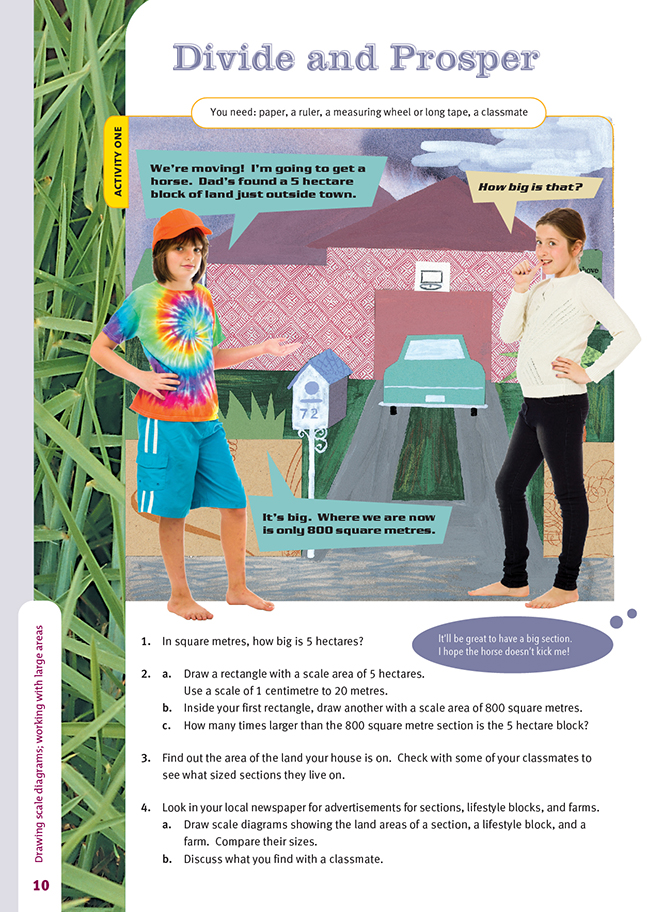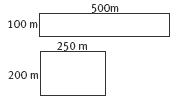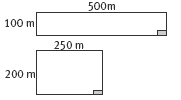Divide and Prosper
This is a level 4 measurement strand activity from the Figure It Out series.
A PDF of the student activity is included.
Click on the image to enlarge it. Click again to close. Download PDF (401 KB)
draw scale diagrams for length and area problems
paper, ruler, a measuring wheel or long tape
FIO, Level 4, Measurement, Book One, Divide and Prosper
classmate
Activity One
The hectare is the basic unit of land area for all but very large areas (in which case, the units used are square kilometres). This activity is designed to help students visualise and use hectares.
The key fact is that 1 hectare = 10 000 square metres. Although a hectare can have any shape whatsoever, it is helpful to think of it as a square measuring 100 metres x 100 metres. As the students will learn when they do the activity, a full-sized rugby field is around 100 metres x 50 metres, or half a hectare. It is worth revisiting this comparison repeatedly until everyone in the class remembers it for life!
In question 2, students are asked to draw 2 rectangles to scale, one inside the other. Those who have difficulty getting underway with this can draw lengths such as 1 centimetre, 2 centimetres, and 5 centimetres, then label them in metre equivalents using the scale 1 centimetre to 20 metres.
When doing question 3, those who live in their own homes can ask their parents the size of their section. They will either have this piece of information in their head or will be able to find it on the title deed. Those living in rented properties are unlikely to have ready access to this information, but they could find it out through the local council. Some cities have property data such as section size and rateable value freely available on their websites. Alternatively, the students could estimate the size of their section by pacing it out.
Question 4 asks students to investigate real estate advertising in local newspapers, with the students comparing the sizes of different types of properties. Some students may wish to visit real estate web pages for this information. Others may be interested in asking an agent what makes a piece of land a “lifestyle block”.
Activity two
In this activity, the students need to be able to break up a shape into smaller shapes (a rectangle and triangle) so that they can work out the area. They also need to understand the relationship between kilometres and metres.
In question 2, the scale suggested is tight for an A4 page. An alternative would be to use a scale of 1 centimetre to 200 metres or to use A3 paper.
Question 3 is another investigation of real estate. This time, the object is to find the current cost of lifestyle blocks in your area. If your school gets bundles of newspapers, they will come in handy for this exercise.
Investigation
The local council or a land surveyor would be able to explain what is required when subdividing land. The students may be surprised to learn that there are many requirements to be met and major costs involved.
This is true even when dividing a residential section in two. If you live in an area where a major piece of land is being developed for housing, the process may be a suitable project for a pair of interested students, who could then report their findings to the class.
Cross-curricular links
Social Studies
This activity could be part of an investigation into local history, looking at the way land use has changed and how a town or city has grown as big blocks of land have been progressively subdivided over time. Such a study could include historic Māori use, old farmlands or orchards, present-day lifestyle blocks, and infill housing.
Achievement Objective
Demonstrate knowledge and understandings of:
- how places reflect past interactions of people with the environment (Place and Environment, level 4)
Answers to Activities
Activity one
1. 50 000 m2. (5 x 10 000 m2. )
2. a. Rectangles may vary. Two possibilities are illustrated here, but with the size reduced:
b. The section should be 2 cm by 1 cm. (On these diagrams, it is shown as a small grey rectangle.)
c. 62.5 times. (50 000 ÷ 800 = 62.5)
3. Answers will vary. Residential sections are commonly in the range 500 to 1 000 m2.
4a.–b. Answers will vary.
5. A full-sized field is about 100 x 50 = 5 000 m2. which is half a hectare.
Activity two
1. 250 ha. (The area can be divided into a triangle with a base of 1 km and a height of 1 km and a rectangle with a base of 2 km and a height of 1 km.
Total area = ( x 1 x 1) + (2 x 1) = 2.5 km2.
As 1 km2 = 100 ha, the area = 2.5 x 100 = 250 ha.)
2. There are different ways of dividing the property, but this is probably the simplest:
3. Answers will vary.
Investigation
Costs will include paying surveyors, contractors, legal fees, council approval costs, and so on.




